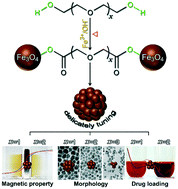当前位置:
X-MOL 学术
›
CrystEngComm
›
论文详情
Our official English website, www.x-mol.net, welcomes your
feedback! (Note: you will need to create a separate account there.)
Molecular mechanisms for delicately tuning the morphology and properties of Fe3O4 nanoparticle clusters†
CrystEngComm ( IF 2.6 ) Pub Date : 2018-03-23 00:00:00 , DOI: 10.1039/c8ce00056e Xiaojun Wei 1, 2, 3, 4, 5 , Lihong Jing 1, 2, 3, 4, 5 , Chunyan Liu 1, 2, 3, 4, 5 , Yi Hou 1, 2, 3, 4, 5 , Mingxia Jiao 4, 5, 6, 7, 8 , Mingyuan Gao 1, 2, 3, 4, 5
CrystEngComm ( IF 2.6 ) Pub Date : 2018-03-23 00:00:00 , DOI: 10.1039/c8ce00056e Xiaojun Wei 1, 2, 3, 4, 5 , Lihong Jing 1, 2, 3, 4, 5 , Chunyan Liu 1, 2, 3, 4, 5 , Yi Hou 1, 2, 3, 4, 5 , Mingxia Jiao 4, 5, 6, 7, 8 , Mingyuan Gao 1, 2, 3, 4, 5
Affiliation

|
Herein, a polyol method has been explored for producing magnetic iron oxide nanoparticle clusters that are potentially useful as contrast agents for magnetic resonance imaging (MRI), as drug carriers in tumor therapy, and for bioseparation. The oriented attachment growth of primary particles is widely accepted as a major driving force for the formation of clusters; on the other hand, the commonly used high-boiling point alcohols are used as high-temperature reaction media and reductants in particular for the formation of primary magnetite nanoparticles. However, the role of alcohols remains far from being understood. Herein, systematic studies were carried out to further reveal the molecular role of the high-boiling point alcohols and that of the commonly used stabilizing agent poly(acrylic acid) (PAA). The impact of the structure of alcohols, e.g., monohydric and dihydric alcohols with different chain lengths, on the morphology of the resulting clusters was investigated in detail. The experimental results reveal that the crosslinking effect of the oxidized dihydric alcohols determines the formation of Fe3O4 particle clusters, whereas PAA helps in the formation of spherical clusters by reducing the surface tension. Based on a combination of magnetic measurements and drug loading tests, the impacts of the structures of dihydric alcohols on the magnetic properties, especially on the magnetic response to external fields and drug loading capacities, have been disclosed; in brief, the current study clearly discloses the role of the high-boiling point alcohols in the formation of magnetite particle clusters for the first time, which is beneficial for fine tuning the overall morphology and internal molecular structure of the resulting particle clusters to improve their magnetic response, drug loading efficiency, and MRI contrast enhancing performance.
中文翻译:

精细调节Fe 3 O 4纳米粒子簇的形态和性能的分子机制†
在本文中,已经研究了多元醇方法以生产磁性氧化铁纳米粒子簇,其潜在地可用作造影剂以用于磁共振成像(MRI),用作肿瘤治疗中的药物载体以及用于生物分离。初级粒子的定向附着生长是形成团簇的主要驱动力,被广泛接受。另一方面,通常使用的高沸点醇用作高温反应介质和还原剂,特别是用于形成初级磁铁矿纳米颗粒。但是,酒精的作用仍远未弄清。在本文中,进行了系统研究以进一步揭示高沸点醇和常用的稳定剂聚丙烯酸(PAA)的分子作用。酒精结构的影响,例如,对具有不同链长的一元和二元醇进行了详细研究。实验结果表明,氧化二元醇的交联作用决定了Fe 3 O 4的形成。颗粒团簇,而PAA通过降低表面张力来帮助形成球形团簇。基于磁性测量和载药量测试的结合,已经揭示了二元醇的结构对磁性能的影响,特别是对外部磁场和载药量的磁响应的影响。简而言之,当前的研究首次清楚地揭示了高沸点醇在磁铁矿颗粒团簇形成中的作用,这有利于微调所得颗粒团簇的整体形态和内部分子结构,以改善它们的形成。磁响应,药物装载效率和MRI对比增强性能。
更新日期:2018-03-23
中文翻译:

精细调节Fe 3 O 4纳米粒子簇的形态和性能的分子机制†
在本文中,已经研究了多元醇方法以生产磁性氧化铁纳米粒子簇,其潜在地可用作造影剂以用于磁共振成像(MRI),用作肿瘤治疗中的药物载体以及用于生物分离。初级粒子的定向附着生长是形成团簇的主要驱动力,被广泛接受。另一方面,通常使用的高沸点醇用作高温反应介质和还原剂,特别是用于形成初级磁铁矿纳米颗粒。但是,酒精的作用仍远未弄清。在本文中,进行了系统研究以进一步揭示高沸点醇和常用的稳定剂聚丙烯酸(PAA)的分子作用。酒精结构的影响,例如,对具有不同链长的一元和二元醇进行了详细研究。实验结果表明,氧化二元醇的交联作用决定了Fe 3 O 4的形成。颗粒团簇,而PAA通过降低表面张力来帮助形成球形团簇。基于磁性测量和载药量测试的结合,已经揭示了二元醇的结构对磁性能的影响,特别是对外部磁场和载药量的磁响应的影响。简而言之,当前的研究首次清楚地揭示了高沸点醇在磁铁矿颗粒团簇形成中的作用,这有利于微调所得颗粒团簇的整体形态和内部分子结构,以改善它们的形成。磁响应,药物装载效率和MRI对比增强性能。











































 京公网安备 11010802027423号
京公网安备 11010802027423号